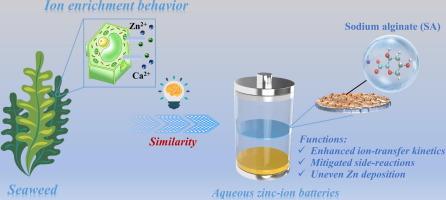A seaweed-inspired separator for high performance Zn metal batteries: Boosting kinetics and confining side-reactions
IF 13.1
1区 化学
Q1 Energy
引用次数: 0
Abstract
Uncontrolled dendrite growth, sluggish reaction kinetics, and drastic side reactions on the anode-electrolyte interface are the main obstacles that restrict the application prospect of aqueous zinc-ion batteries. Traditional glass fiber (GF) separator with chemical inertness is almost ineffective in restricting these challenges. Herein, inspired by the ionic enrichment behavior of seaweed plants, a facile biomass species, anionic sodium alginate (SA), is purposely decorated on the commercial GF separator to tackle these issues towards Zn anode. Benefiting from the abundant zincophilic functional groups and superior mechanical strength properties, the as-obtained SA@GF separator could act as ion pump to boost the Zn2+ transference number (0.68), reduce the de-solvation energy barrier of hydrated Zn2+, and eliminate the undesired concentration polarization effect, which are verified by experimental tests, theoretical calculations, and finite element simulation, respectively. Based on these efficient modulation mechanisms, the SA@GF separator can synchronously achieve well-aligned Zn deposition and the suppression of parasitic side-reactions. Therefore, the Zn||Zn coin cell integrated with SA@GF separator could yield a prolonged calendar lifespan over 1230 h (1 mA cm−2 and 1 mAh cm−2), exhibiting favorable competitiveness with previously reported separator modification strategies. Impressively, the Zn-MnO2 full and pouch cell assembled with the SA@GF separator also delivered superior cycling stability and rate performance, further verifying its practical application effect. This work provides a new design philosophy to stabilize the Zn anode from the aspect of separator.

用于高性能锌金属电池的海藻启发式隔膜:促进动力学和限制副反应
阳极-电解质界面不受控制的枝晶生长、缓慢的反应动力学和剧烈的副反应是限制锌离子水电池应用前景的主要障碍。具有化学惰性的传统玻璃纤维(GF)隔膜几乎无法有效限制这些挑战。本文受海藻植物离子富集行为的启发,特意在商用玻璃纤维隔膜上装饰了一种简便的生物质物种--阴离子海藻酸钠(SA),以解决锌阳极的这些问题。得益于丰富的亲锌官能团和优越的机械强度特性,所获得的 SA@GF 分离器可作为离子泵提高 Zn2+ 迁移数(0.68),降低水合 Zn2+ 的脱溶能障,并消除不希望出现的浓度极化效应,这些都分别通过实验测试、理论计算和有限元模拟得到了验证。基于这些高效的调制机制,SA@GF 分离器可以同步实现锌的均匀沉积和抑制寄生副反应。因此,集成了 SA@GF 分离器的 Zn||Zn 纽扣电池可延长日历寿命超过 1230 h(1 mA cm-2 和 1 mAh cm-2),与之前报道的分离器改性策略相比,表现出良好的竞争力。令人印象深刻的是,与 SA@GF 分离器组装在一起的 Zn-MnO2 全电池和袋式电池还具有优异的循环稳定性和速率性能,进一步验证了其实际应用效果。这项工作从分离器方面为稳定锌阳极提供了一种新的设计理念。
本文章由计算机程序翻译,如有差异,请以英文原文为准。
求助全文
约1分钟内获得全文
求助全文
来源期刊

Journal of Energy Chemistry
CHEMISTRY, APPLIED-CHEMISTRY, PHYSICAL
CiteScore
19.10
自引率
8.40%
发文量
3631
审稿时长
15 days
期刊介绍:
The Journal of Energy Chemistry, the official publication of Science Press and the Dalian Institute of Chemical Physics, Chinese Academy of Sciences, serves as a platform for reporting creative research and innovative applications in energy chemistry. It mainly reports on creative researches and innovative applications of chemical conversions of fossil energy, carbon dioxide, electrochemical energy and hydrogen energy, as well as the conversions of biomass and solar energy related with chemical issues to promote academic exchanges in the field of energy chemistry and to accelerate the exploration, research and development of energy science and technologies.
This journal focuses on original research papers covering various topics within energy chemistry worldwide, including:
Optimized utilization of fossil energy
Hydrogen energy
Conversion and storage of electrochemical energy
Capture, storage, and chemical conversion of carbon dioxide
Materials and nanotechnologies for energy conversion and storage
Chemistry in biomass conversion
Chemistry in the utilization of solar energy
 求助内容:
求助内容: 应助结果提醒方式:
应助结果提醒方式:


